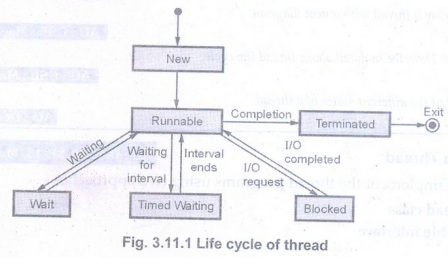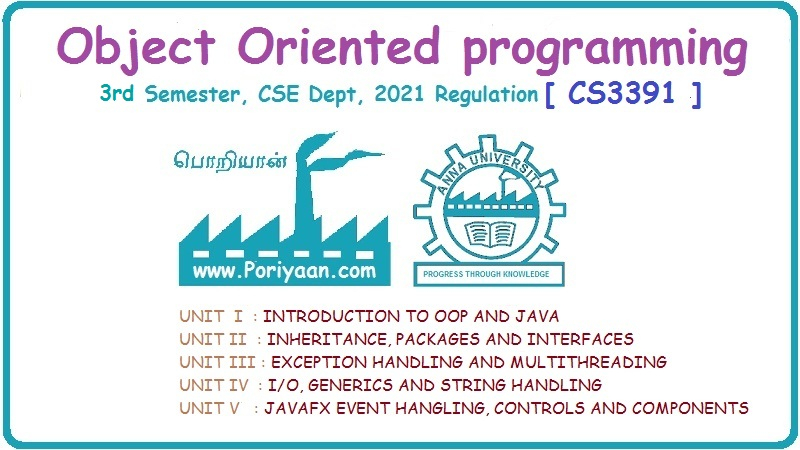Object Oriented Programming: Unit III: Exception Handling and Multithreading
Two marks Questions with Answers
Exception Handling and Multithreading | Object Oriented Programming
Exception is a mechanism which is used for handling unusual situation that may occur in the program.
Two Marks
Questions with Answers
Q.1 What
is an exception? Give example.
Ans:
Exception is a mechanism which is used for handling unusual situation that may
occur in the program. For example -
ArithmeticException:
This exception is used to handle arithmetic exceptions such as divide by zero,
IOException: This exception occurs when
an illegal input/output operation is performed.
Q.2 What will happen if an exception is not
caught?
Ans. An
uncaught exception results in invoking of the uncaughtException() method. As a
result eventually the program will terminate in which it is thrown.
Q.3 What is the benefit of exception handling?
Ans.
When calling method encounters some error then the exception can be thrown.
This avoids crashing of the entire application abruptly.
Q.4 What is the difference between error and
exception in java?
Ans.
Errors are mainly caused by the environment in which an application is running.
For example, OutOfMemoryError happens there is shortage of memory. Where as
exceptions are mainly caused by the application itself. For example,
NullPointerException occurs when an application tries to access null object.
Q.5 What is compile time and run time error?
Ans;
1.The
errors that are detected by the Java compiler during the compile time are
called compiler time errors.
2. The
runtime errors are basically the logically errors that get caused due to wrong
logic.
Q.6 What
is the use of try, catch keywords?
Ans. :
try - A block of source code that is to be monitored for the exception.
catch -
The catch block handles the specific type of exception along with the try
block.
Q.7 What
is the difference between throw and throws?
Ans. :
1. The
throw keyword is used to explicitly throw an exception.
2. The
throws keyword is used to declare an exception.
Q.8 What is ArrayIndexOutOfBoundsException?
Ans.
When we use an array index which is beyond the range of index then
ArrayIndexOutOfBoundsException occurs.
Q.9 What is the need of multiple catch?
Ans.:
• There
may be the situations in which different exceptions may get raised by a single
try block statements and depending upon the type of exception thrown it must be
caught.
• To
handle such situation multiple catch blocks may exist for the single try block
statements.
Q.10 There are three statements in a try block
- statement1, statement2 and statement3. After that there is a catch block to
catch the exceptions occurred in the try block. Assume that exception has
occurred in statement2. Does statement3 get executed or not?
Ans. No.
Once a try block throws an exception, remaining statements will not be
executed. Control comes directly to catch block.
Q.11 Explain the types of exceptions.
Ans.
There are two types of exceptions:
1. Checked Exception: These
types of exceptions need to be handled explicitly by the code itself either by
using the try-catch block or by using throws. These exceptions are extended
from the java.lang.Exception class.
For
example: IOException which should be handled using the try-catch block.
2. Unchecked Exception: These
type of exceptions need not be handled explicitly. The Java Virtual Machine
handles these type of exceptions. These exceptions are extended from
java.lang.RuntimeException class.
For
example: ArrayIndexOutOfBounds, NullPointerException, RunTimeException.
Q.12 Does finally block get executed If either
try or catch blocks are returning the control?
Ans.
Yes, finally block will be always executed no matter whether try or catch
blocks are returning the control or not.
Q.13 Can we have empty catch block?
Ans. Yes
we can have empty catch block, but it is an indication of poor programming
practice. We should never have empty catch block because if the exception is
caught by that block, we will have no information about the exception and it
will create problem while debugging the code.
Q.14 Which class is the super class for all
types of errors and exceptions in java ?
Ans. The
java.lang.Throwable is the super class for all types of errors and exceptions
in java.
Q.15 What is runtime exceptions?
Ans.
RuntimeException is the superclass of those exceptions that can be thrown
during the normal operation of the Java Virtual Machine. Runtime Exception is
the parent class in all exceptions of the Java.
Q.16 What is exception handling?
Ans.
Exception handling is a mechanism in which the statements that are likely to cause
an exception are enclosed within try block. As soon as exception occurs it is
handled using catch block.
Thus
exception handling is a mechanism that prevents the program from crashing when
some unusual situation occurs.
Q.17 What happens when the statement int value
= 25/0 is executed?
Ans. The
exception Arithmetic Exception: Divide by zero will occur.
Q.18 What do you mean by threads in Java ?
Ans.
Thread is tiny program running continuously. It is a light weight process in
Java..
Q.19
Give the difference between process and thread.
Ans.

Q.20 What are different stages in thread?
Ans.
Various stages in thread are
1. New
state
2. Time
waiting state
3.Runnable
state
4. Waiting
state
5.Blocked
state
6.
Terminated state
Q.21 What do you mean by synchronization ?
Ans.
When two or more threads need to access shared memory, then there is some way
to ensure that the access to the resource will be by only one thread at a time.
The process of ensuring one access at a time by one thread is called
synchronization.
Q.22 What are the three ways by which the
thread can enter in waiting stage?
Ans. :
i) Waiting state:
Sometimes one thread has to undergo in waiting state because another thread
starts executing. This can be achieved by using wait() state.
ii) Timed waiting state: There
is a provision to keep a particular threading waiting for some time interval.
This allows to execute high prioritized threads first. After the timing gets
over, the thread in waiting state enters in runnable state. This can be
achieved by using the sleep() command.
iii) Blocked state : When a particular thread issues an input/output request
then operating system sends it in blocked state until the I/O operation gets
completed. After
the I/O
completion the thread is sent back to the runnable state. This can be achieved
by using suspend() method.
Q.23 What is multithreading?
Ans.
Multithreading is an environment in which multiple threads are created and they
can execute simultaneously. The multiple threads can be created either by
extending the thread class or by implementing the runnable interface.
Q.24 Mention two mechanisms for protecting a
code block from concurrent access.
Ans.
There are two mechanisms for protecting a code block from concurrent access -
1. Use
of reentrant code
2. Use
synchronized block
Q.25 What is meant by notify methods in
multithreading?
Ans. The
notify() method is used for inter thread communication. If a particular thread
is in the sleep mode then that thread can be resumed by using the notify call.
Q.26 What are the two ways of creating a
thread?
Ans.
Thread can be created using
1.
Thread class 2. runnable interface.
Q.27 Why do we need run() and start() method
both? Can we achieve it with only run() method?
Ans. We
use start() method to start a thread instead of calling run() method because
the run() method is not a regular class method. It should only be called by the
JVM. If we call the run() method directly then it will simply invoke the
caller's thread instead of its own thread. Hence the start() method is called
which schedules the thread with the JVM.
Q.28 What is the need for thread?
Ans. In
Java threads are used to handle multiple tasks together. This kind of
programming is called concurrent programming.
Q.29 Name any four thread constructor.
Ans. :
1.
Thread()
2.
Thread(String name).
3.
Thread(Runnable target)
4.
Thread (Runnable target, String name)
Q.30 When thread is initiated and created, what
is its initial stage?
Ans. : A
thread is in "Ready" state after it has been created and started.
This state signifies that the thread is ready for execution. From here, it can
be in the running
state.
Q.31 "Thread is a lightweight
process" - Comment
Ans.
Threads
do not require separate address for its execution. It runs in the address space
of the process to which it belongs to. Hence thread is a lightweight process.
Q.32 Sketch the life cycle of thread

Object Oriented Programming: Unit III: Exception Handling and Multithreading : Tag: : Exception Handling and Multithreading | Object Oriented Programming - Two marks Questions with Answers
Related Topics
Related Subjects
Object Oriented Programming
CS3391 3rd Semester CSE Dept | 2021 Regulation | 3rd Semester CSE Dept 2021 Regulation
